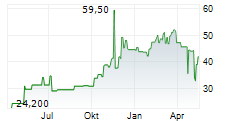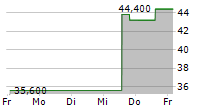WARREN, N.J., Aug. 19, 2025 /PRNewswire/ -- PTC Therapeutics, Inc. (NASDAQ: PTCT) announced today that the U.S. Food and Drug Administration (FDA) has issued a Complete Response Letter (CRL) related to the New Drug Application (NDA) for vatiquinone for the treatment of children and adults living with Friedreich's ataxia.
"We are of course disappointed by the FDA's decision to not approve vatiquinone," said Matthew B. Klein, M.D., Chief Executive Officer of PTC Therapeutics. "We believe the data collected to date demonstrate that vatiquinone could provide a safe and effective therapy for both children and adults living with Friedreich's ataxia. We plan to meet with the FDA to discuss potential steps to address the issues raised in the CRL."
The FDA stated in the CRL that substantial evidence of efficacy was not demonstrated for vatiquinone and that an additional adequate and well-controlled study would be needed to support NDA resubmission.
About Vatiquinone
Vatiquinone is a small molecule, first-in-class selective inhibitor of 15-Lipoxygenase (15-LO), an enzyme that is a key regulator of the energetic and oxidative stress pathways that are disrupted in Friedreich's ataxia. Inhibition of 15-LO helps to alleviate the consequences of mitochondrial dysfunction and oxidative stress, ultimately decreasing inflammation and oxidative stress and promoting neuronal survival.1,2,3 Vatiquinone has been evaluated in a number of clinical studies, many focused on pediatric patients, and has demonstrated an impact on mortality risk, and a number of neurological and neuromuscular disease symptoms.
About Friedreich's Ataxia
Friedreich's ataxia (FA) is a rare, physically debilitating, life-shortening, neuromuscular disorder that mainly affects the central nervous system and the heart.4 It is the most common hereditary ataxia (abnormal, uncoordinated movements) and is usually caused by a single genetic defect in the frataxin (FXN) gene that leads to reduced production of frataxin, a mitochondrial protein that is important for cellular metabolism and energy production.4,5 Decreased frataxin levels are associated with mitochondrial iron accumulation and increased oxidative stress, which can lead to cell death through ferroptosis.6,7,8
Symptoms include progressive loss of coordination and muscle strength leading to poor balance and coordination, difficulty speaking, swallowing, and breathing, curvature of the spine, serious heart conditions, diabetes, and hearing and vision impairment.9,10 The severity of symptoms and speed of progression varies between people and some symptoms may not be evident in all. Friedreich's ataxia is usually diagnosed in childhood or adolescence.5,11 Approximately 25,000 people have Friedreich's ataxia globally.
About PTC Therapeutics, Inc.
PTC is a global biopharmaceutical company dedicated to the discovery, development and commercialization of clinically differentiated medicines for children and adults living with rare disorders. PTC is advancing a robust and diversified pipeline of transformative medicines as part of its mission to provide access to best-in-class treatments for patients with unmet medical needs. The company's strategy is to leverage its scientific expertise and global commercial infrastructure to optimize value for patients and other stakeholders. To learn more about PTC, please visit www.ptcbio.com and follow on Facebook, X, and LinkedIn.
For More Information:
Investors:
Ellen Cavaleri
+1 (615) 618-6228
[email protected]
Media:
Jeanine Clemente
+1 (908) 912-9406
[email protected]
Forward-Looking Statement:
This press release contains forward-looking statements within the meaning of The Private Securities Litigation Reform Act of 1995. All statements contained in this press release, other than statements of historic fact, are forward-looking statements, including statements with respect to the future expectations, plans and prospects for PTC; PTC's plans for further interactions with the FDA; PTC's plans for vatiquinone including with respect to the expected timing of clinical trials and studies, availability of data, regulatory submissions and responses and other matters; PTC's strategy, future operations, future financial position, future revenues, projected costs; and the objectives of management. Other forward-looking statements may be identified by the words, "guidance", "plan," "anticipate," "believe," "estimate," "expect," "intend," "may," "target," "potential," "will," "would," "could," "should," "continue," and similar expressions.
PTC's actual results, performance or achievements could differ materially from those expressed or implied by forward-looking statements it makes as a result of a variety of risks and uncertainties, including those related to: the outcome of pricing, coverage and reimbursement negotiations with third party payors for PTC's products or product candidates that PTC commercializes or may commercialize in the future; expectations with respect to vatiquinone, including any clinical trials, regulatory submissions, commercialization, the potential achievement of regulatory and sales milestones and contingent payments that PTC may be obligated to make; significant business effects, including the effects of industry, market, economic, political or regulatory conditions; changes in tax and other laws, regulations, rates and policies; the eligible patient base and commercial potential of PTC's products and product candidates; PTC's scientific approach and general development progress; and the factors discussed in the "Risk Factors" section of PTC's most recent Quarterly Report on Form 10-Q and Annual Report on Form 10-K, as well as any updates to these risk factors filed from time to time in PTC's other filings with the SEC. You are urged to carefully consider all such factors.
As with any pharmaceutical under development, there are significant risks in the development, regulatory approval and commercialization of new products. There are no guarantees that any product will receive or maintain regulatory approval in any territory, or prove to be commercially successful, including vatiquinone.
The forward-looking statements contained herein represent PTC's views only as of the date of this press release and PTC does not undertake or plan to update or revise any such forward-looking statements to reflect actual results or changes in plans, prospects, assumptions, estimates or projections, or other circumstances occurring after the date of this press release except as required by law.
References:
- Hinman A, et al. PLoS one. 2018;13:e0201369.
- PTC Therapeutics. EPI-743 Pre-Clinical Data Deck.
- Shrader WD, et al. Bioorg Med Chem Lett. 2011;21:3693-3698.
- Lynch DR, Farmer JM, Balcer LJ, et al. Arch Neurol?2002;59(5):743-747.
- Campuzano V, Montermini L, Lutz Y, et al. Hum Mol Genet 1997;11(6):1771-1780.
- Campuzano V, et al. Hum Mol Genet. 1997;6:1771-1780.
- Cook A, Giunti P. Br Med Bull. 2017;124:19-30.
- Pandolfo M, Hausmann L. J Neurochem. 2013;126:142-146.
- Bürk K. Cerebellum Ataxias 2017;4:4.
- Cook A, Giunti P. Br Med Bull 2017;124(1):19-30.
- Delatycki MB, Williamson R, Forrest SM.?J Med Genet 2000;37(1):1-8.
SOURCE PTC Therapeutics, Inc.




